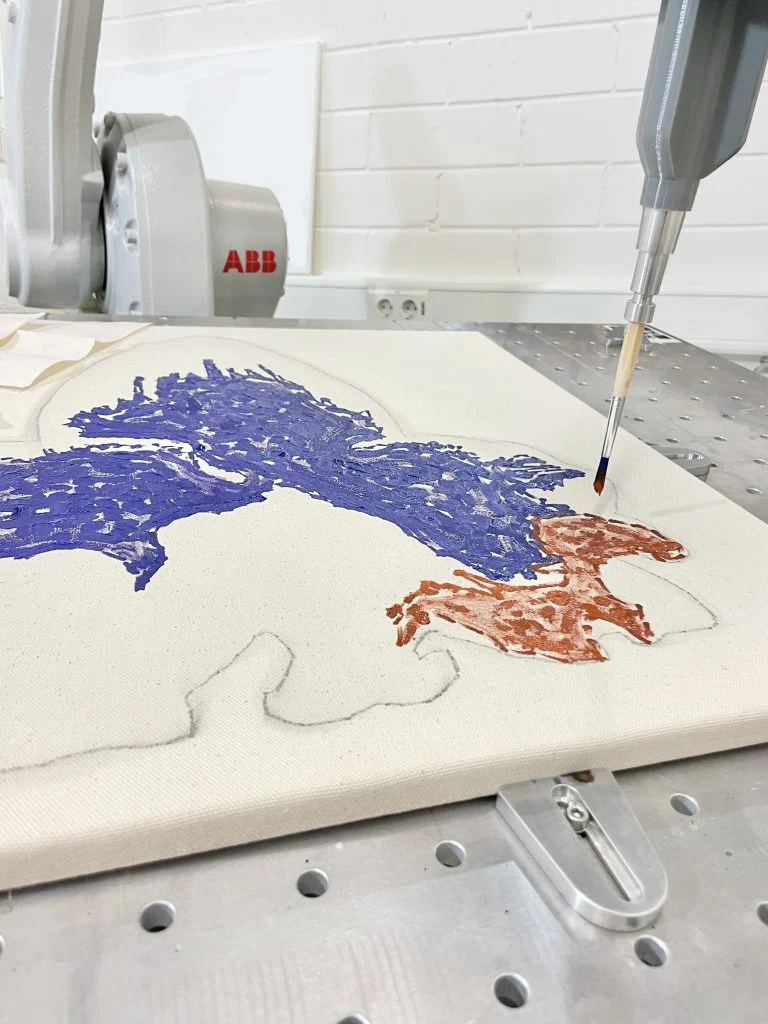Press
Today’s A.I. discourse is misleading—and robotic painting reveals just how much gets lost between flashy demos and the messy reality of making art.

Full Article by Gretta Louw at Artnet.com
‘Einen Riesigen Schwarm’ video work by Gretta Louw played on the largest digital screen in Germany on the Königsallee in Düsseldorf as part of DC Open.
While interest in NFTs is lagging, a whole host of artists are moving forward the conversation around A.I.
Art is essential to human intelligence and … AI
“A project to develop computationally-generated calligraphy and graffiti which looks convincingly human has been awarded a 2021 Artists + Machine Intelligence Research Award from Google”
“In this edition of PassW0rd we ask the question can AI be creative?
It’s one of the burning issues of the 21st century as AI begins to be tasked with challenges that would defeat a human being such as finishing off Beethoven’s 10th Symphony from notes and fragment the musical genius left when he died or predicting the next notes in a Bach composition.”
Keynotes & Workshop
- „European ARTificial Intelligence Lab” – Veronika Liebl, Ars Electronica
- „Occupy White Walls. Democratise ART” – Yarden Yaroshevski, StikiPixels
- Liat Grayver (Künstlerin), Justine Emard (Artist), Mattis Kuhn (Artist) and Andreas Greiner (Artist) together with AI Design Sprints™, 33A

Brush in hand, dip into the paint and paint away! It seems easy for us humans. But when a robot is supposed to paint with a brush, things often go wrong. And then it spills.
The robot e-David is a painting robot. He is in Switzerland for the first time and will be demonstrating his skills at the grafikSCHWEIZ18 trade fair in Zurich.
Is there a “formula” for art? If so, e-David, a robot created by computer scientists at the University of Konstanz in Germany, may help solve it.
The brush-wielding bot, whose name is an acronym for “drawing apparatus for vivid image display,” sports a camera, a palette of 24 colors, and software that lets it calculate just where to put the paint to create a predetermined image. Once the painting is complete, e-David even eerily signs its work
For e-David, the robotic painting agent, the act of painting is broken down and separated into segments that are translated into the world of digital creation, where it is performed by e-David.
A robot develops an artistic life of its own: How a computer scientist and an artist teach a machine to be creative. And how painting robots could one day also work in industry.
“So far, computers have mainly imitated humans. But can they really be creative, compose or write poetry?” By Boris Hänßler
At the University of Konstanz, the industrial robot “e-David” paints lots of pictures. The scientists want to find out whether a machine can “think” artistically. This is the robot’s work.
Constance (dpa) – At the University of Konstanz, a robot paints with real paint on real canvas – amazingly precise and authentic. But what distinguishes art from good craftsmanship? Will we even need artists in the future?
The line between art and technology isn’t just being blurred, it’s being erased altogether. Painting or sketching from photographs and life, for example, is a technique that is now being mastered by robots. The latest, called eDavid, combines a camera, computer vision software, and a standard welding robot arm to skillfully recreate (in a variety of styles no less) any image you feed its software. It seems that even art, a cornerstone of human ingenuity since the dawn of man, isn’t safe from a robot takeover.
A team at the University of Konstanz in Germany have developed e-David as a robot “artist” that uses software to decide where to add the next brush stroke. After each brush stroke, e-David takes a picture, and its software calculates such moves as where the image needs to be lightened or darkened.
E-David isn’t the first industrial robotic arm that’s been re-programmed to paint. There have been many similar creations before it, but they’ve all worked sort of like elaborate photocopiers, perfectly recreating a digital image stored in memory. What sets e-David apart is that it’s the first robot painter that constantly adapts its technique and brush strokes as it works based on what it’s seeing through a camera pointed at its canvas.
The human hand has been painting pictures for millennia, and over that time we’ve evolved techniques and invented various styles and movements. And now that evolution has brought us to program machines to paint just like us. The e-David is a robotic arm that doesn’t just paint abstract forms, but picks up a paintbrush to create portraits and even signs its own name.